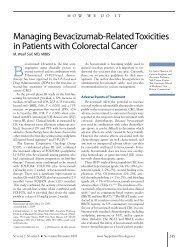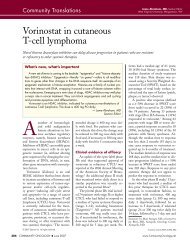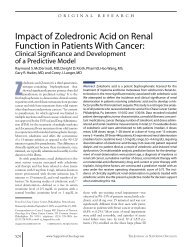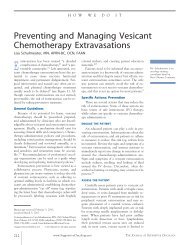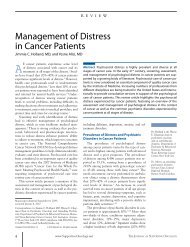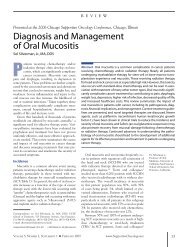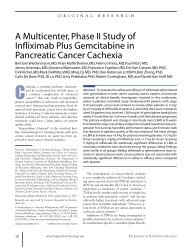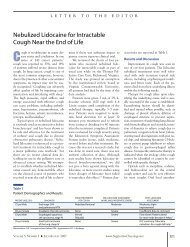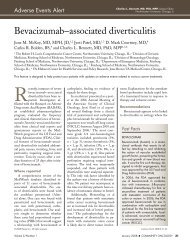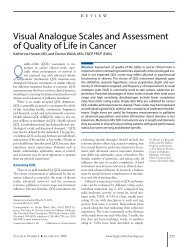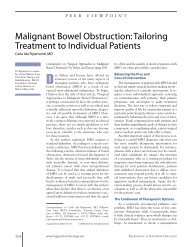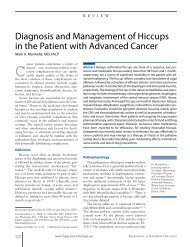Volume 9 Number 3 March 2012 - Oncology Practice Digital Network
Volume 9 Number 3 March 2012 - Oncology Practice Digital Network
Volume 9 Number 3 March 2012 - Oncology Practice Digital Network
You also want an ePaper? Increase the reach of your titles
YUMPU automatically turns print PDFs into web optimized ePapers that Google loves.
Review<br />
triggering MM responses. For example, MM cells secrete<br />
DKK-1, which downregulates osteoblast function via an<br />
effect on Wnt signaling. In our preclinical murine xenograft<br />
models of human MM, the neutralizing anti-<br />
DKK-1 BHQ880 MoAb not only triggers new bone<br />
formation, but also inhibits MM cell growth; 53 a clinical<br />
trial of BHQ880 MoAb is ongoing. We have also shown<br />
that B-cell activating factor (BAFF) is elevated in the BM<br />
plasma of patients with MM and mediates osteoclastogenesis,<br />
as well as tumor cell survival and drug resistance;<br />
anti-BAFF MoAb can neutralize these effects, 54 and a<br />
clinical trial of this MoAb is ongoing. Most recently, we<br />
have shown that targeting BTK in our preclinical models<br />
not only blocks osteoclast formation and growth, thereby<br />
maintaining bone integrity, but also inhibits MM cell<br />
growth. These studies illustrate the principle that targeting<br />
cytokines or accessory cells in the tumor microenvironment<br />
can also impact MM cell growth, further validating<br />
the utility of our in vitro and in vivo model<br />
systems.<br />
Preclinical studies to identify combination<br />
targeted therapies<br />
We have used functional oncogenomics to inform the<br />
design of novel combination therapies. For example, bortezomib<br />
was shown to inhibit DNA damage repair in<br />
vitro, 27 providing the rationale for its combination with<br />
DNA damaging agents to enhance or overcome drug<br />
resistance. Indeed, a large randomized phase III trial of<br />
bortezomib versus bortezomib with pegylated doxorubicin<br />
showed prolonged PFS and overall survival and increased<br />
extent and frequency of response with the combination,<br />
55 leading to FDA approval of bortezomib with<br />
pegylated doxorubicin to treat relapsed MM.<br />
In a second example, we found heat shock protein 27<br />
(Hsp 27) to be increased at transcript and protein levels in<br />
patient MM cells in the setting of bortezomib refractoriness.<br />
Our bedside-back-to-bench studies showed that<br />
overexpression of Hsp 27 conferred bortezomib resistance,<br />
whereas knockdown of Hsp 27 in bortezomibresistant<br />
MM cells restored sensitivity. 56 Hideshima and<br />
colleagues then showed that p38MAPK inhibitor decreased<br />
downstream Hsp 27 and thereby overcame bortezomib<br />
resistance in MM cell lines and patient cells, 57<br />
providing the rationale for a clinical trial of bortezomib<br />
and p38MAPK inhibitor.<br />
In another example, based upon hallmark cyclin D<br />
abnormalities in MM, Raje and colleagues have studied<br />
cyclin D kinase inhibitors alone and in combination in<br />
MM. 58,59 In addition, Ghobrial and colleagues have<br />
translated promising preclinical data on an mTOR inhibitor<br />
and bortezomib into clinical trials. 60 We also have<br />
shown that bortezomib triggers activation of Akt, and<br />
that bortezomib with the Akt inhibitor perifosine can<br />
overcome resistance to bortezomib in preclinical models.<br />
61 Our phase I and II trials of this combination therapy<br />
showed durable responses even in the setting of bortezomib<br />
resistance, and a phase III trial of bortezomib<br />
versus bortezomib with perifosine in relapsed MM is<br />
ongoing.<br />
Finally, we believe that protein homeostasis represents<br />
one of the most attractive novel therapeutic targets in<br />
MM. Specifically, we have shown that inhibition of the<br />
proteasome upregulates aggresomal degradation of protein,<br />
and, conversely, that blockade of aggresomal degradation<br />
induces compensatory upregulation of proteasomal<br />
activity. 62 Most important, blockade of aggresomal and<br />
proteasomal degradation of proteins by histone deacetylase<br />
(HDAC) inhibitors (vorinostat, panobinostat, tubacin)<br />
and proteasome inhibitors (bortezomib, carfilzomib),<br />
respectively, triggers synergistic MM cell cytotoxicity in<br />
preclinical studies. 62-64 We are leading international<br />
phase I/II trials combining the HDAC inhibitors vorinostat<br />
or panobinostat with bortezomib, which have thus<br />
far shown that responses are achieved in the majority of<br />
patients with relapsed bortezomib-refractory MM, as well<br />
as phase III trials for FDA registration of these combinations.<br />
A very promising finding is that an HDAC6-<br />
selective inhibitor causes acetylation of tubulin and more<br />
potently and selectively blocks aggresomal protein degradation,<br />
providing synergistic MM cytotoxicity when combined<br />
with bortezomib. This combination has rapidly<br />
translated from our laboratory to the bedside in clinical<br />
trials aimed at determining whether clinical efficacy can<br />
be achieved without the side effect profile of fatigue,<br />
diarrhea, thrombocytopenia, and cardiac abnormalities<br />
associated with the more broad type HDAC1 or 2<br />
inhibitors.<br />
To date, the most exciting combination emerging from<br />
our preclinical studies is that of lenalidomide and bortezomib,<br />
with the respective caspase 8-mediated apoptosis<br />
and caspase 9-mediated apoptosis inducing synergistic<br />
cytotoxicity in models of MM cells in the BM milieu. 65<br />
Richardson and colleagues led efforts to translate these<br />
findings to clinical trials in advanced MM, which showed<br />
that lenalidomide, bortezomib, and dexamethasone<br />
achieved a response rate of 58% in relapsed MM that was<br />
often refractory to either agent. 66 Most important, our<br />
center has shown that lenalidomide, bortezomib, and<br />
dexamethasone combination therapy achieves a response<br />
rate of 100% in newly diagnosed MM, with 74% of<br />
patients having at least very good partial response and<br />
52% having complete or near complete response. 45 Given<br />
these unprecedented results, a clinical trial is now evalu-<br />
90 COMMUNITY ONCOLOGY <strong>March</strong> <strong>2012</strong> www.Community<strong>Oncology</strong>.net



